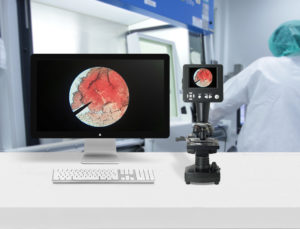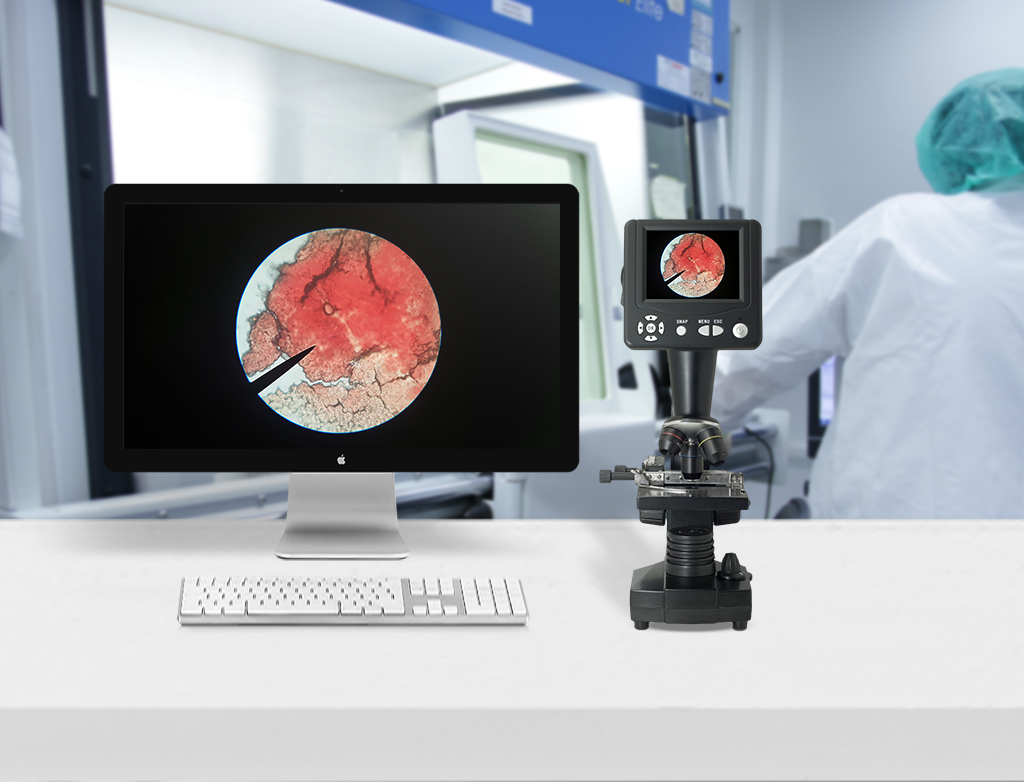Digital Microscope Eyepieces are an important part of a digital microscope. You call eyepieces as oculars too. To get the best view out of your digital microscope, your choice of eyepieces should fit the type and correction of objectives that you are using perfectly.
What Are Microscope Eyepieces?
The eyepiece lens of a microscope is one of the essential parts. And it is because it’s where it would all start. If you are familiar using a microscope, you surely know the main function of it. But for newbies and beginners alike, the microscope eyepiece lens is mainly the lens at the top of instrument. It is actually where you look through when inspecting or observing a specimen or subject.
On a normal basis, the power of an eyepiece ranges from 10x up to 15x. And having this kind of level is already fitting for any user of a microscope. But, this kind of eyepiece is only designed for the conventional types of microscopes. And as it happens, eyepiece lens does not actually exist in a digital microscope.
So, the real question in this part is, what are digital microscope eyepieces?
About Digital Microscope Eyepieces
Apparently, the eyepiece lens of a conventional microscope is far different  from the eyepiece lens of a digital microscope. In fact, digital types do not have an eyepiece lens. They are only considered eyepiece because they just work the same in a sense that users can see the specimen or subject through it.
from the eyepiece lens of a digital microscope. In fact, digital types do not have an eyepiece lens. They are only considered eyepiece because they just work the same in a sense that users can see the specimen or subject through it.
These so-called eyepiece lenses are simple eyepiece cameras. And they are utilized by attaching the camera into the microscope. In short, when you see the subject or the specimen on your monitor or screen, the eyepiece camera is the one working its functions. And without it, you will not be able to see through the subjected specimen and sample.
All in all, having an eyepiece camera is mainly the thing that sets the conventional microscopes apart from the digital microscopes.
How The Eyepiece Camera Works
So, you already know that an eyepiece camera is different from the conventional eyepiece lens. And the way it works is far different as well from one another.
Keep in mind that eyepiece lens work in the sense that users would only look through it to see the specimen or the subject that is under the microscope. On the other hand, eyepiece camera is mainly the one that transmits the image of the specimen going to the monitor or the screen.
If you look at the Digital Microscope Eyepieces, you will see that it comes with inscriptions. A high-eyepoint focal point comes with an H designation.
Other inscriptions that you see include WF meaning Wide-Field; UWF meaning Ultra-Wide Field; SW or SWF for Super-Wide Field; HE for High Eyepoint; and CF. You use the CF with corrected objectives. Compensating eyepieces are inscribed with comp, C, or K and their magnification. As for those used for flat-field objectives, they are often labeled Plan-Comp.
Although the main functions of the eyepiece cameras are pretty straightforward, there are still a few variations depending on the type of the eyepiece camera and digital microscope. Nevertheless, it is pretty easy to use and very convenient. And this is one of the many reasons why a lot of beginners choose to buy a digital microscope.
If you want a closer look at how these pieces work, this is a quick video that you may want to utilize. And this is actually perfect for beginners who do not have any idea on how to utilize digital microscope eyepieces and their accompanying features and functions.
User Convenience and Ease of Use
For more convenient positioning of your eyepieces, you can manipulate its thumbscrew and for better focus, you can also use its focus adjustment settings. Most eyepieces that you see these days come with rubber eyecups. It positions the eyes properly at a distance from the front lens. They also help block room light that might interfere with the view and reflect off the surface of your lens.
There are two groups of eyepieces depending on their diaphragm and lens arrangement. First, you have the negative eyepieces that come with an internal diaphragm, and second, you have the positive eyepieces that come with a diaphragm found below the eyepiece lenses. The former type of eyepiece has an upper lens and a lower lens. Both lenses come with convex sides that face the specimen. Midway between these lenses is where you can find the internal diaphragm or a fixed circular opening. Its simplest design is what you call the Huygenian eyepiece.
The Ramsden Digital Microscope Eyepieces is the positive eyepiece that has a diaphragm found below its lenses. It comes with a field lens and an eye lens that are plano-convex. The field lens is mounted, having the curved surface facing the eye lens. For better correction, the two lenses are cemented together.
The simple eyepieces made mention, namely the Huygenian and the Ramsden, and their achromatized counterparts are not capable of correcting any residual chromatic magnification difference in the intermediate image. That is why compensating Digital Microscope Eyepieces are made so there will be equal yet opposite chromatic error in the lenses. Compensating eyepieces are the reason why residual chromatic aberrations will be eliminated during magnification.
Tip to Using Your Eyepiece
As mentioned, using digital microscope eyepieces is very straightforward. And certainly, you would not experience any struggle even if it is going to be your first time. But, it is always wise to follow the instructions and recommendations of the manufacturers. And this is because correcting your eyepiece and objective combination requires strategies. And these strategies may vary. Even so, you will learn more about your own strategy and technique as you go along the way of using digital microscopes.
As for choosing the most appropriate digital microscope eyepieces, ensure to buy the parts you need for your microscope, it’s best to know your objective first. By then, you can buy an eyepiece that is suitable for what you need.




